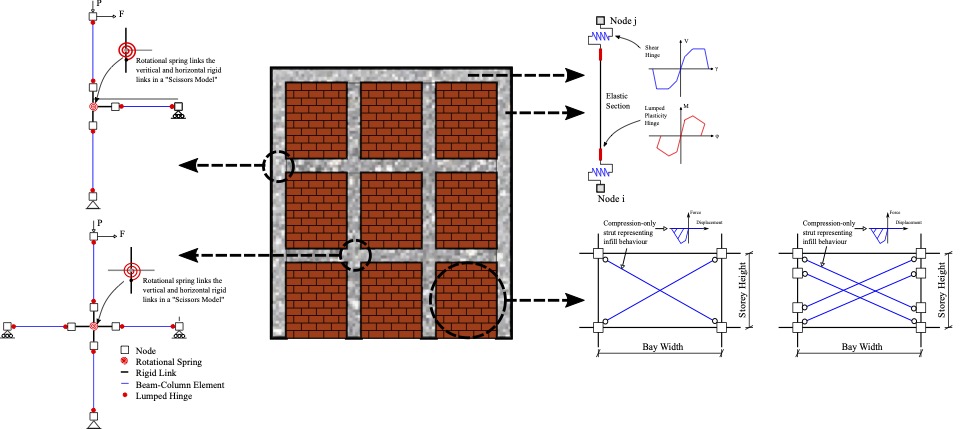Non-Ductile Building Model Database
Overview
RC structures with masonry infills are one of the most prevalent typologies of the southern European region. Considering the prevalence of this typology in Europe and Italy, this work aims to develop a database of archetypical buildings that may be considered representative of this existing stock found throughout Italy and Southern Europe.
The period between the mid-1970s and 1980s witnessed the implementation of the equivalent lateral force (ELF) method. The ELF method requires a seismic coefficient, defined as around 7%-10% by Crowley et al. [2021] and other studies. This design approach was coupled with the allowable stress method for the dimensioning and detailing of structural members. The main guidelines were L. 1086/71, D.M. 40/1975 and D.M. 108/1986. Features of this sub-standard design (SSD) practice at the time include frames spanning in one (or both) directions, the use of deformed rebars and concrete with moderate yield and compressive strengths respectively, but still with no consideration of ductile detailing.
Throughout the 1990s, technical standards were updated with additional requirements and provisions. This period preceded the Eurocodes and saw the introduction of design using response spectrum analysis. This method is a linear elastic approach to calculate the modal, or peak, responses and was adopted for the design and sizing of the members. Construction features of this high seismic design (HSD) approach include frames in both directions, deformed rebars with higher yield strengths (430 MPa), concrete with higher compressive strength (25 MPa), but no mandatory capacity-based design and seismic detailing of members, as described in Gesualdi et al. [2020]. The three construction practices described here have been labelled GLD (pre-1970s), SSD (1970-1980) and HSD (1980-2000).
Architectural layouts
Based on expert architectural judgement, obtained through consultation with practitioners and review of past guidelines, the case study layouts were conceived, with examples illustrated below.

The geometric configuration and architectural features were selected to reflect the function and form of the Italian design space over different building periods as much as possible. For instance, narrow hallways and corridors in dwellings generally 150 cm wide were an architectural feature of residential buildings constructed with infilled RC frames structures. Adjacent kitchens and bathrooms were also a common feature. Plumbing fixtures such as bathtubs, sinks and bidets whose dimensions were used for optimised space allocation were installed. Adequate separation of the day and night living spaces was an important feature. Windows with widths corresponding to a multiple of 45 or 60 cm were used. The staircase width did not exceed 3 m (i.e. wide enough to allow the passage of two people) and landings did not exceed a depth of 1.3 m. For perimeter walls corresponding to the façade of the building, a 24 cm infill was utilised, whereas for the separation of dwellings and encasing of stairs, a 30 cm infill of was used. Both considered thicknesses correspond to a double-leaf system used for thermal and acoustic insulation and fire-retarding. Considering walls used as interior partition elements for the compartmentalisation of the living space within a single dwelling, a panel thickness of 80 mm is used corresponding to a single-leaf system. The architectural considerations highlighted herein do not just reflect the archetype design space adopted but can provide further information on the building’s non-structural component inventory in an economic loss-oriented scenario, which is also an important facet in seismic risk assessment and classification.
Numerical modelling
Numerical models of the archetypes were developed in OpenSees using a three-dimensional lumped plasticity approach. Beams and columns were modelled considering an elastic beam-column element with cracked section properties and zero-length elements located at a finite plastic hinge length, as illustrated below. The empirical calibration for strength and deformation capacities and hysteresis parameters proposed by Di Domenico et al. [2021] was adopted for columns with plain rebars (for GLD and SSD). The modelling approach by O’Reilly & Sullivan [2019] was implemented considering an empirical calibration using experimental data. The flexural response of members was implemented in OpenSees through rotational springs (i.e. zero-length elements) and a Pinching4 hysteretic material model. The shear strength model by Sezen and Moehle [2004] was considered by coupling the flexural and shear springs in both principal directions at a finite plastic hinge location. For ductile members, which corresponds to the HSD cases, the flexural response parameters calibrated by Haselton et al. [2007] were used and the shear response was modelled as elastic. Additionally, staircase elements were modelled to account for their added stiffness and potential to induce torsional behaviour.

For beam-column joints, the empirical relationships derived by De Risi et al. [2016] and O’Reilly & Sullivan [2019] were considered respectively for exterior and interior joints in non-ductile structures, with both approaches adopting a lumped scissors-type modelling approach. Joints with poor detailing and smooth reinforcing bars with end-hooks were modelled using zero-length elements using the Hysteretic material model in OpenSees to account for flexural and axial behaviours. Rigid offsets were accounted for adequately in the geometric dimensions of beam-column members.
Furthermore, the in-plane behaviour of masonry infill panels was modelled using the equivalent strut approach [Crisafulli et al., 2000]. The option of single and double struts is available in the models. The difference in infill strength (weak, medium and strong) used herein were considered following the characterisation performed in Hak et al. [2012]. Weak infills were used as internal partition elements within a single dwelling, whereas medium and strong infills were used for facades and partitioning of dwelling-to-dwelling and dwelling-to-stairway, as previously described.
These models have been fully implemented and are available at the aforementioned GitHub repository here along with several other useful documents and material regarding their structural behaviour and properties.
